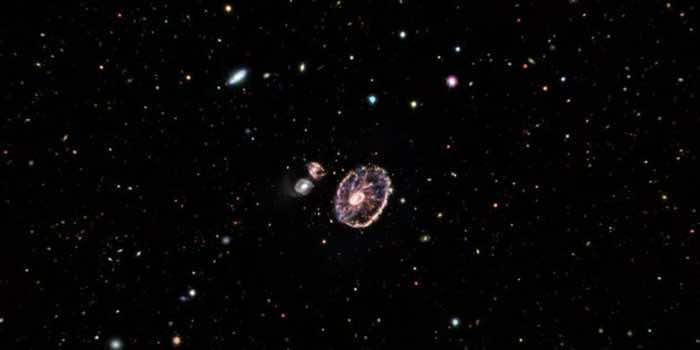The $10 billion (£7.4 billion) observatory’s powerful infrared gaze produced a rare sight of the Cartwheel and two smaller companion galaxies against a backdrop of many other galaxies.
Scientists say the detailed view will provide new details about star formation and the galaxy’s central black hole.

Its appearance resembles the wheel of a wagon and is the result of an intense event — a high-speed collision between a large spiral galaxy and a smaller galaxy not visible in this image or video.
The dramatic galaxy has been covered in mystery, perhaps literally, given the amount of dust that obscures the view.
‘This image of the Cartwheel and its companion galaxies is a composite from Webb’s Near-Infrared Camera (NIRCam) and Mid-Infrared Instrument (MIRI), which reveals details that are difficult to see in the individual images alone,’ NASA said.
‘Webb’s observations capture Cartwheel in a very transitory stage.
‘The form that the Cartwheel Galaxy will eventually take, given these two competing forces, is still a mystery.
‘However, this snapshot provides perspective on what happened to the galaxy in the past and what it will do in the future.’
Collisions of galactic components lead to the formation of different, smaller events between the galaxies involved; the Cartwheel is no exception.
The Cartwheel Galaxy has two rings — a bright inner ring and a surrounding, colorful ring. These rings extend outwards from the center of the collision. Astronomers have named this a ‘ring galaxy’, a structure less common than spiral galaxies like our Milky Way.
The bright has a massive amount of hot dust with the brightest areas being the home to gigantic young star clusters.
Meanwhile, the outer ring has expanded for about 440 million years. It is dominated by star formation and supernovas. As this ring expands, it plows into surrounding gas and triggers star formation.
Learning finer details about the dust that inhabits the galaxy, however, requires Webb’s Mid-Infrared Instrument (MIRI).
MIRI data are colored red in this composite image, revealing regions within the Cartwheel Galaxy rich in hydrocarbons and other chemical compounds, as well as silicate dust, like much of the dust on Earth.
The spokes are evident in previous Hubble observations released in 2018, but they become much more prominent in this Webb image.
Webb’s infrared capabilities allow it to ‘see back in time’ to within a mere 100-200 million years of the Big Bang. This enables it to snap pictures of the very first stars to shine in the universe more than 13.5 billion years ago.
Researchers will soon begin to learn more about the galaxies’ masses, ages, histories and compositions, as Webb seeks to explore the earliest galaxies in the universe.


